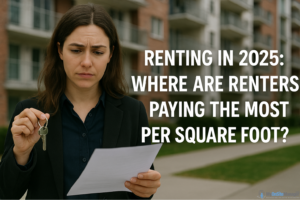As the housing market adjusts to economic shifts, interest rate changes, and population growth, renters in 2025 are feeling the pressure more than ever—especially in America’s biggest cities. A recent study from Storage Sense highlights a new way to look at rental affordability: how much renters are paying per 100 square feet of space.
By focusing on cost per square footage, the report provides a clearer picture of the true value (or lack thereof) renters are receiving for their monthly payments, especially in major urban markets where space is a premium commodity.
Top 10 U.S. Cities With the Highest Rent per 100 Square Feet
Here’s a breakdown of the ten most expensive large cities (population 500,000+) in the U.S. when it comes to rent relative to space:
1. Washington, D.C.
-
Average Home Size: 932 sq. ft.
-
Median 1-Bedroom Rent: $2,137
-
Rent per 100 sq. ft.: $229.29
-
Available Homes per 100,000 People: 1,351
D.C. tops the list, showing just how expensive the capital city has become—not only in total rent but in cost per square foot. Renters here pay the highest for the smallest average space on the list.
2. San Francisco, CA
-
Average Home Size: 1,222 sq. ft.
-
Median 1-Bedroom Rent: $2,761
-
Rent per 100 sq. ft.: $225.94
-
Availability: 508 homes per 100K
San Francisco maintains its reputation as one of the least affordable places to live. Despite larger average unit sizes, its high median rent drives up the cost per square foot significantly.
3. New York City, NY
-
Average Home Size: 1,165 sq. ft.
-
Median 1-Bedroom Rent: $2,219
-
Rent per 100 sq. ft.: $190.47
-
Availability: 196 homes per 100K
New York’s rental crunch is no surprise. With one of the lowest availabilities on the list, competition remains fierce and space comes at a steep price.
4. Boston, MA
-
Average Home Size: 1,251 sq. ft.
-
Median 1-Bedroom Rent: $2,210
-
Rent per 100 sq. ft.: $176.66
-
Availability: 2,154 homes per 100K
Boston offers slightly more breathing room in terms of available units, but the price per square foot remains high—indicating a steady demand for well-located urban living.
5. San Jose, CA
-
Average Home Size: 1,582 sq. ft.
-
Median 1-Bedroom Rent: $2,410
-
Rent per 100 sq. ft.: $152.34
-
Availability: 297 homes per 100K
While rents are high, San Jose offers more space than most other cities on this list—great for families or those needing home office space.
6. San Diego, CA
-
Average Home Size: 1,467 sq. ft.
-
Median 1-Bedroom Rent: $1,950
-
Rent per 100 sq. ft.: $132.92
-
Availability: 637 homes per 100K
San Diego provides slightly more affordable rent relative to space, but still ranks in the top tier for cost per square foot.
7. Seattle, WA
-
Average Home Size: 1,460 sq. ft.
-
Median 1-Bedroom Rent: $1,875
-
Rent per 100 sq. ft.: $128.42
-
Availability: 1,546 homes per 100K
Seattle continues to be a tech-driven market, where competitive salaries and job opportunities drive up rental prices despite relatively generous home sizes.
8. Los Angeles, CA
-
Average Home Size: 1,544 sq. ft.
-
Median 1-Bedroom Rent: $1,843
-
Rent per 100 sq. ft.: $119.37
-
Availability: 635 homes per 100K
Los Angeles shows a lower cost per square foot compared to its California neighbors, but affordability is still a major concern for residents battling housing scarcity and rising costs.
9. Chicago, IL
-
Average Home Size: 1,400 sq. ft.
-
Median 1-Bedroom Rent: $1,535
-
Rent per 100 sq. ft.: $109.64
-
Availability: 518 homes per 100K
While not traditionally viewed as a high-cost rental city, Chicago’s square footage value shows that it’s catching up—especially in popular neighborhoods.
10. Philadelphia, PA
-
Average Home Size: 1,318 sq. ft.
-
Median 1-Bedroom Rent: $1,256
-
Rent per 100 sq. ft.: $95.30
-
Availability: 939 homes per 100K
Philadelphia ranks lowest in rent per square foot among the top 10, offering the best value on this list for renters who want to stretch their space without maxing out their budget.
What This Means for Renters
As demand continues to outpace supply in most major U.S. cities, these findings underscore how critical it is for renters to consider not just monthly rent, but the amount of space they get for that money.
Key takeaways:
-
Smaller units in high-demand cities like D.C. and NYC can end up costing more per square foot than larger homes in smaller metros.
-
Availability varies widely, which impacts both price and competition.
-
Cities like San Jose and Seattle may offer more room but still carry high price tags because of tech-fueled demand.
Whether you’re a renter looking to relocate, or a property manager analyzing rent trends, knowing the cost per square foot can be an essential tool in today’s housing market.
Source: OnFocus News – Renting in 2025: The U.S. Cities with the Highest Rent Revealed

